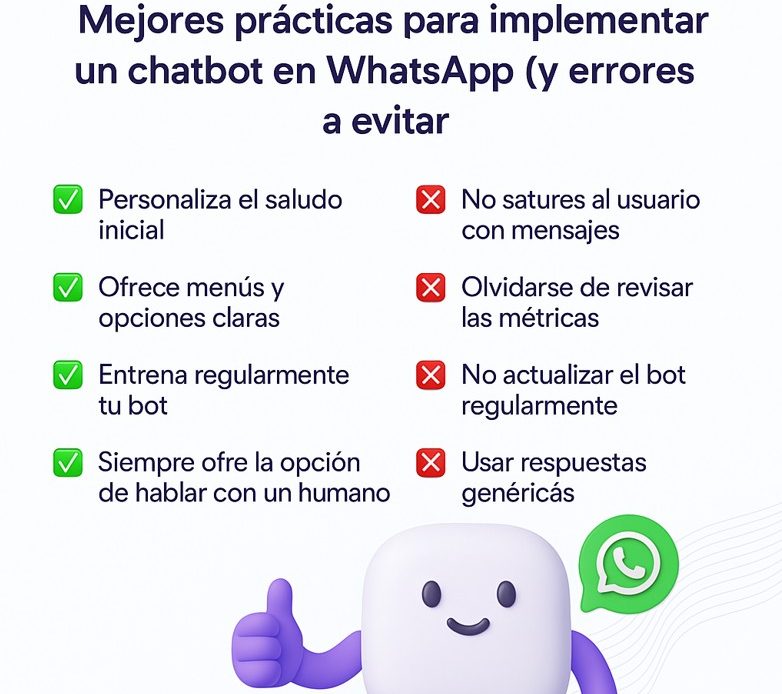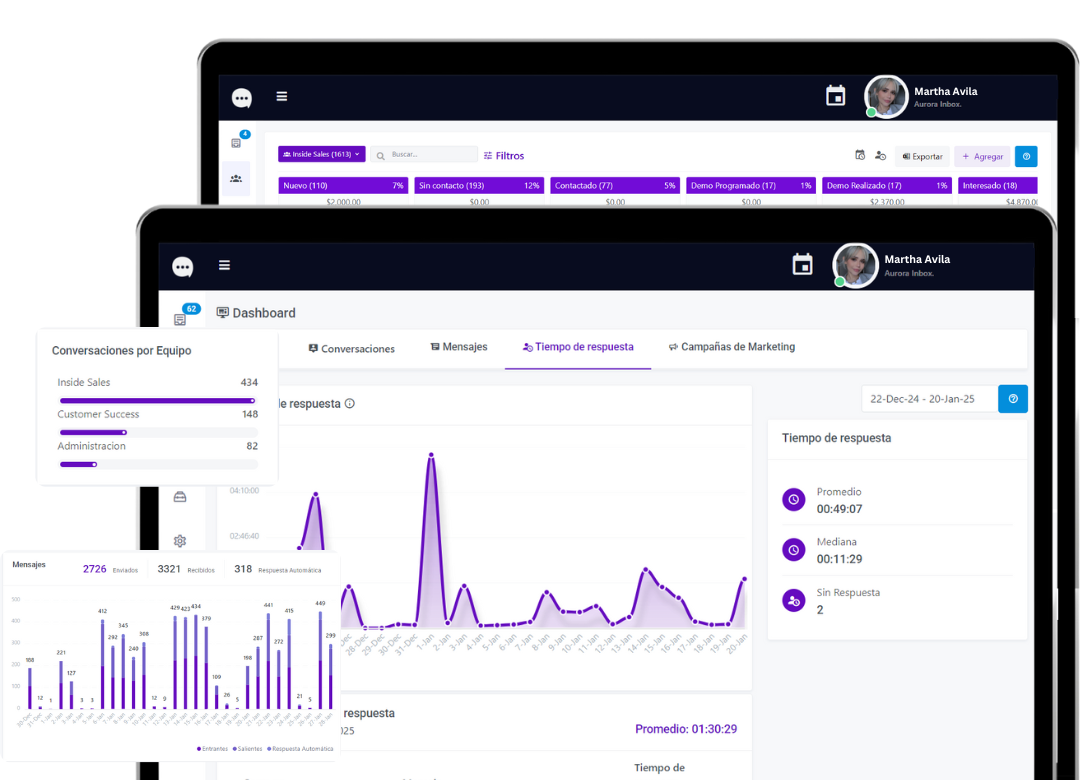When you decide to start a chatbot on WhatsApp, one of the first questions that arise is: “How can I ensure it works optimally?” The reality is that it is not enough to create it and launch it; there is a set of best practices that will help you take full advantage of its potential. There are also common mistakes that can sabotage your strategy if you don't avoid them in time. In this article you will discover both sides of the coin: what Yeah you should do and what No.
Why implement a chatbot on WhatsApp?
Before delving into the dos and don'ts, it's important to emphasize the relevance of this platform. WhatsApp is the most used messaging app in many Spanish-speaking countries, which means that your customers are already there. A well-configured chatbot can:
- Automate frequently asked questions to save time and resources.
- Offer 24/7 assistance (even outside of working hours).
- Guide the user to the information or department you need.
- Collect data in an orderly manner (for example, for quotes or scheduling appointments).
However, making this happen smoothly requires following a series of Best practices for chatbots on WhatsApp and at the same time avoid common mistakes that could ruin the user experience.
Best practices for a WhatsApp chatbot
Below, we share a list of practices that have proven to be effective in the implementation of chatbots for WhatsApp:
✅ 1. Define clear objectives
Before scheduling your first message, ask yourself:
- What do I want the chatbot for?
- What problems will it help solve?
- What are the KPIs for success?
Having clear objectives (for example, "reduce response time to potential customers") will allow you to design conversation flows aligned with those goals. This way, the bot won't simply be an "automatic greeting," but a tool that adds real value to your business.
✅ 2. Personalize the welcome message
The implementation of a chatbot on WhatsApp It should start with a good first impression. A personalized welcome message (mentioning the company name, the chatbot's purpose, and a friendly tone) helps build trust. Remember, WhatsApp is an intimate and personal environment for the user; a friendly greeting makes a big difference.
Welcome message example:
“Hi! Thanks for contacting [Your Company]. I'm your virtual assistant and I'm here to help you with any questions. How can I help you today?”
✅ 3. Offer clear menus and options
Most users don't want to read endless paragraphs or go around in circles trying to find what they're looking for. Keep the menu simple with basic options:
- Product/service information
- Schedules and locations
- Check the status of an order
- Talk to a human
Facilitating navigation not only streamlines the experience but also reduces user frustration. This organized structure will also help you collect more accurate metrics on the most frequently visited routes.
✅ 4. Maintain a tone consistent with your brand
Even though it's a chatbot, it's still a extension of your brandIf your company has a youthful, relaxed tone, your bot should reflect that as well. Conversely, if you have a more formal tone (for example, in legal or financial services), make sure your responses are consistent with that identity.
✅ 5. Always offer the option to speak to a human
Even the best chatbot can encounter situations that require the intervention of a real agent. Make sure to include in your Chatbot implementation for WhatsApp A seamless handover system that allows the user to quickly connect with a human when needed. This increases trust and avoids the feeling of being "stuck talking to a machine."
✅ 6. Update and train your bot regularly
The frequently asked questions Chatbots change over time, new promotions or products emerge, and customers may ask questions differently. If you don't keep your bot up to date, it will end up offering outdated or incomplete information. Schedule regular check-ins (at least once a month) to train your chatbot with new question variations and keep your content fresh.
✅ 7. Measure and analyze key metrics
An intelligent chatbot is not just the one that answers: it is the one that learn from interaction with users. Monitor data such as:
- Number of conversations started
- Questions successfully solved by the bot
- Transfer rate to a human agent
- Average response times
These metrics will tell you where to improve your workflows and what questions or complaints are recurring. Tools like Aurora Inbox make this task easier, allowing you to centralize conversations and collect statistics for continuous optimization.
Common mistakes to avoid in your WhatsApp chatbot
Now that you know the best practices, it's time to look at the other side of the coin: The mistakes that can cause your WhatsApp chatbot implementation to fail.
❌ 1. Not informing the user that they are interacting with a bot
Some businesses fear that revealing that it's a bot might discourage people, but the opposite is true: transparency builds trust. If the user thinks they're talking to a real person and discovers they're not, they'll feel deceived. Therefore, make it clear that it's a virtual assistant, assuring them they'll have access to a human agent whenever they need it.
❌ 2. Overwhelm the user with long answers
Excessively long texts tire readers and they get lost on the mobile screen. WhatsApp is a flexible channel; keep your responses short and to the point. If you need to provide additional details, offer them through links or downloadable PDFs, but don't fill the screen with endless paragraphs.
❌ 3. Forgetting to check metrics
One of the WhatsApp chatbot errors The most common mistake is to implement it and then "forget" about it. A bot left unattended will simply repeat the same responses, without improving or adapting. Remember that it's crucial to measure the effectiveness of your chatbot and adjust your strategy based on the results.
❌ 4. Not updating content regularly
Users may encounter outdated information (e.g., last season's opening hours, expired promotions, old prices), which creates confusion and a negative impression. An "old" chatbot will ultimately be useless in the eyes of your audience.
❌ 5. Limit yourself to generic answers
If your bot repeats "I don't understand your question" to any variation of the user's words, you'll miss valuable automation opportunities. Train your chatbot with synonyms and common phrases your customers might use, especially if there are local peculiarities or jargon specific to your industry.
❌ 6. Do not offer a quick exit
Have you ever been stuck in a menu that forces you to click through multiple options without finding the one you need? In WhatsApp, this is especially frustrating because it stays in a single conversation window. Always gives the user the ability to return to the main menu or directly access a human with a simple command (“Talk to an advisor”).

Implement these best practices with Aurora Inbox
By following these recommendations and avoiding the errors mentioned, you will have a chatbot on WhatsApp Truly efficient, it will serve your users quickly and cordially, and it will boost your business objectives.
Would you like all this to be easier? With Aurora Inbox (example link), you can:
- Centralize all your WhatsApp conversations.
- Create chatbot flows friendly and easy to update.
- Monitor metrics in real time to constantly improve.
- Transfer seamlessly to a human agent if necessary.
We invite you to request a free demo and discover how Aurora Inbox helps you implement all these good practices without complications. Give your business the competitive advantage it deserves!
Optimize your business today!
Find out how Aurora Inbox's AI agent for WhatsApp can revolutionize your customer service. Schedule a meeting to meet with him and take your service to the next level.
We are here to help you grow!



